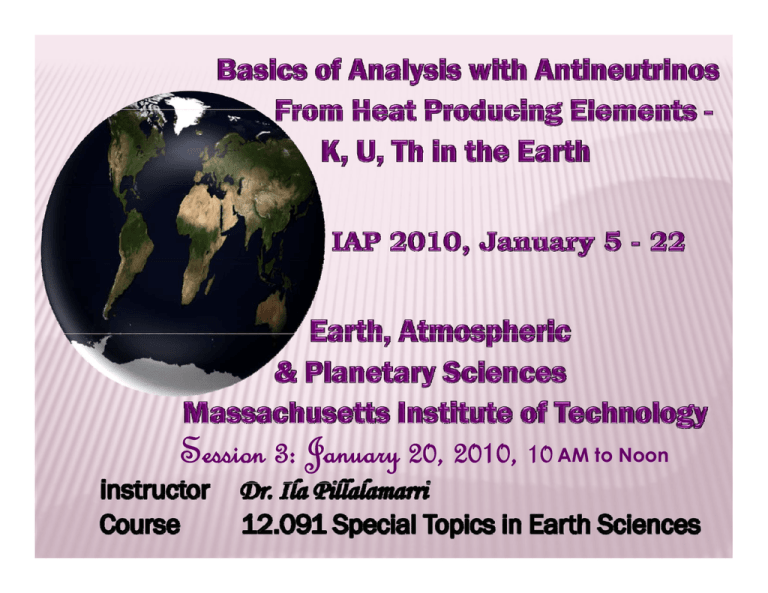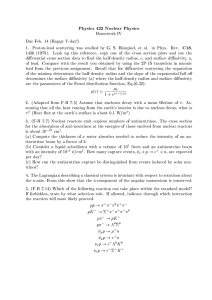Session 3: January 20, 2010, 10 AM to Noon
advertisement

Session 3: January 20, 2010, 10 AM to Noon 1) Relevance to antineutrino analysis of global concentration determination of radiogenic heat producing elements (HPE) by terrestrial heat flow studies and Bulk Silicate Earth (BSE) models, and unconventional models of the Earth’s core. 2) Basic radiation characteristics of heat producing elements (HPE): Alpha, beta, gamma, neutrino and antineutrino radiations, p , Basics of radiation detection concepts, Special focus: Antineutrino radiation detection, Antineutrino radiation detection with directional sensitivity. 2 3) Relevance of existing large antineutrino detectors for probing the HPE in Earth’s deep interior: Characteristics, research and contributions of the two existing antineutrino detectors – Sudbury Neutrino Observatory (SNO), Canada and Kamioka Liquid Scintillator Antineutrino Detector (KamLAND), Japan. 4) Proposed antineutrino detectors for probing the HPE in Earth’s d deep iinterior i with i h directional di i l sensitivity. i i i TTomography h off the h whole Earth for the localization of the HPE in the deep interior of the Earth. Need for mobile antineutrino detectors for tomography. 5) Considerations for dedicated antineutrino detectors to probe the Earth’s deep interior for the determination of concentrations of heat producing elements. 3 Jan 05: Room 54-312 Relevance to antineutrino R l i i analysis l i off global l b l concentration i determination of radiogenic heat producing elements (HPE) by terrestrial heat flow studies and Bulk Silicate Earth (BSE) models, and unconventional models of the Earth Earth’ss core. core Jan 19: Room 54-312 Basic radiation characteristics of heat producing elements (HPE): Alpha, beta, gamma, neutrino and antineutrino radiations, 40 K decay characteristics, U and Th decay series Basics of radiation detection concepts, Special focus: Antineutrino radiation detection, detection Antineutrino radiation detection with directional sensitivity. 4 Jan 20: Room 54-312 Relevance of existing large antineutrino detectors for probing the HPE in Earth Earth’ss deep interior: Characteristics, research and contributions of the two existing antineutrino detectors – Sudbury Neutrino Observatory (SNO), Canada and Kamioka Liq quid Scintillator Antineutrino Detector (KamLAND), ),Ja pan. Jan 21: Room 54-312 Proposed antineutrino detectors for probing the HPE in Earth’s deep interior with directional sensitivity. Tomography of the whole Earth for the localization of the HPE in the deep interior of the Earth Earth. Need for mobile antineutrino detectors for tomography. Visit to Earth Atmospheric & Planetary Sciences – Radiometric/Neutron Activation Analysis Laboratory (NW13-263). Jan 22: Room 54-312 Considerations for dedicated antineutrino detectors to probe the Earth’s deep interior for the determination of concentrations of heat producing elements. elements. Conclusions. Student Presentations. 5 Jan 20: Room 54-312 Relevance of existing large antineutrino detectors for probing the HPE in deep iinterior: Earth’s E h’ d i Characteristic features of the two existing antineutrino detectors – Sudbury Neutrino Observatory (SNO), Canada and Kamioka Liquid Antineutrino Detector S i till t A Scintillator ti ti D t t (K (KamLAND), LAND) JJapan. Jan 21: Room 54-312 Proposed antineutrino detectors for probing the HPE in Earth’s deep interior with directional sensitivity. sensitivity Tomography of the whole Earth for the localization of the HPE in the deep interior of the Earth. Need for mobile antineutrino detectors for tomography. Visit to Earth Atmospheric & Planetary Sciences – Radiometric/Neutron Activation Analysis Laboratory (NW13-263) (NW13 263) Jan 22: Room 54-312 Conclusions: Considerations for dedicated antineutrino detectors to probe p interior for the determination of concentrations of heat the Earth’s deep producing elements Student Presentations 6 The course work involves the following: 1. 2 2. 3. 4 4. 5. Class attendance and participation Reading assignments Homework assignments Student report Student presentation 25% 25% 15% 15% 15% Required percentage to pass this course is 95%. 7 ¾Basics of ¾Analysis with ¾Antineutrinos from ¾Heat Producing Elements K, U, Th ¾In the Earth 8 Relevance of existing large antineutrino detectors for probing the HPE in Earth’s deep interior: Characteristic features of the two existing antineutrino detectors – q Scintillator Kamioka Liquid Antineutrino Detector (KamLAND), Japan. Sudbury Neutrino Observatory (SNO), Canada. Canada 9 Well established fact is that the heat produced in the interior of the Earth from alpha alpha--, beta beta-radioactivity may be measurable by detecting antineutrinos from the beta decays. decays Essentially, all the antineutrinos reach the s rface of the Earth surface Earth, without itho t att attenuation en ation of the emitted intensity unlike alpha, beta and be Earth gamma rays, so that th t th the whole h l E th can b sampled. Ref. Eder (1966) and Marx (1960, 1969) 10 U and Th abundances and their distributions in the entire Earth are not known, except for a thin layer near the surface where direct sampling is possible. Well known Bulk Silicate Earth (BSE) model and geochemical arguments distribute U and Th masses mainly between the continental crust and the lower Mantle. and thus the geoneutrino flux is exp pected to vary with geographical position of the observational point, decreasing from continental to oceanic sites. Ref. R. Raghavan et al 1998. 11 Antineutrino signal from Crust. Crust ´ Antineutrino signal from Mantle. ´ Antineutrino signal g from Core. ´ They are of interest separately. ´ They Th are nott measured d so far by direct methods. ´ Image by MIT OpenCourseWare 12 ´ ´ ´ ´ ´ Two massive liquid scintillation detectors are built 1. Borexino on continental crust 2. KamLAND on oceanic crust. These two sites in particular, one being on a continental crust and the other at the interface to an oceanic crust, are expected to bring unanticipated perspectives for probing the distribution of U-Th in the Earth’s crust. There have been proposals that detectors stationed at appropriate geographical sites can separate the crust and mantle contributions, thereby to confirm or discard predictions of the Earth’s model. E li proposals Earlier Ref. Rothschild et al, Raghavan et al, Fiorentini et al, Domogatsky et al l 13 ´ ´ p For the methods p proposed towards this g goal in the last 30 years [Ref. Avilez, Krauss, Kobayashi and Fukao, Domogatsky], the most practical is the inverse beta-decay reaction on the protons in a liquid scintillator. The measured antineutrino flux yields the abundance of K, U, Th (HPE) in the whole Earth. 14 ´ ´ ´ Antineutrino detectors are p g usuallyy operated underground in order to reduce the cosmic –ray background interference. The figure shows the reduction in cosmic-ray intensity with depth from the surface of the Earth. Earth For example the cosmic background at Gran Sasso at a depth of about 5000’ is a factor of 10 less than at Kamioka located at about 3500’ deep below belo the surface. 15 Project Name Location KamLAND Existing Kamioka, Japan SNO Existing Sudbury, Canada BOREXINO Existing Italy SNO+ Proposed Sudbury, Canada DOANO P Proposed d Hanohano, H h Pacific Ocean EARTH Proposed p LENA Proposed GRAFG Proposed USA 16 17 KamLAND stands for Kamioka Liquid-scintillator Anti-Neutrino Detector p // jp/ / http://www.awa.tohoku.ac.jp/KamLAND/ 18 KamLAND is located in the Kamioka mine, 1,000 m below the summit of Mt. Ikenoyama, Gifu prefecture, Hida, Japan. o ’ 0 ’ GPS: 36 25 35.562’’ N, 137 18 43.495” E. R f Reference: http://www.awa.tohoku.ac.jp/KamLAND/ http://www.awa.tohoku.ac.jp/KamLAND/kamland_03a-e.html 19 Located in Kamioka mine, under the mountain. Altitude of is 358 m, Rock overburden 2 700 meter 2,700 meter-waterwater equivalent mountain rock under Mt. Ikenoyama (1368 m), About 1000 m below summit http://www.awa.tohoku.ac.jp/KamLAND/News/English/intl-conference/data/Pro-inoue/NOW2004proc.pdf 20 Liquid Scintillator 1000 tonnes Mainly consists of only C and H Fiducial volume 408 tonnes Detector medium container plastic balloon Surrounded by Photo Multiplier Tubes (PMT) 17-inch PMT 1325 20-inch 554 Efficiency 68.7% Yields light on ionization (8000 photons / MeV) http://kamland.stanford.edu/Pictures/Pictures.html http //kamland lbl go /Pict res/ http://kamland.lbl.gov/Pictures/ 21 http://kamland.stanford.edu/Pictures/Pictures.html http://kamland.lbl.gov/Pictures/ 22 KamLAND consists of an 18 m diameter stainless steel spherical vessel ´ 1879 photomultiplier tubes are mounted on the inner surface of the vessel. ´ Inside the sphere is a 13 m diameter nylon balloon filled with liquid scintillator. ´ The scintillator consists of 1,000 , tons of mineral oil, benzene and fluorescent chemicals. ´ 23 The KamLAND Liquid Scintillator consists of 80 v% of normal-Dodecane + 20 v% of Pseudocumene + 1.52 g/liter of PPO (2,5-Diphenyloxazole) where, v% stands for % in volume. PPO is a flour widely used in large scale liquid scintillators. Figureffor mollecullar structure off th Fi hese ch hemiicalls Reference: Suekane, F, T. Iwamoto, H. Ogawa, An Overview of the KamLAND 1-kiloton Liquid Scintillator http://arxiv.org/ftp/physics/papers/0404/0404071.pdf 24 Image g by y MIT OpenCourseWare p Figure. Antineutrino detection by inverse beta Figure decay reaction • Eν > 1.8 MeV • Information of direction of the incident antineutrino will be lost in the detection process by scintillation reaction mechanism. 25 ´ Inverse beta reaction: ´ Delayed « νe + p → e+ + n coincidence signal neutron capture: 2.2 MeV γ, t = 0.2 ms ´ Reaction R ti ´ Natural N t l 1.8 tthreshold: h h ld 1 8 MeV M V isotopes i t with ith Qβ > 1.8 18M MeV V « 214Bi, 234Pa « (U chain) 228Ac, 212Bi (Th chain) 26 References: References: Experimental investigation of geologically produced antineutrinos with KamLAND KamLAND Collaboration, Nature 436, 499-503 (28 July 2005) | doi:10.1038 http://www.nature.com/nature/journal/v436/n7050/abs/nature03980.html 27 ´ ´ ´ ´ ´ ´ KamLAND is the first to determine the antineutrinos from the Earth Earth’ss HPE KamLAND does not have directional sensitivity of the incident antineutrinos arising from the HPE, at the site of interaction in the detector medium. medium This information will be lost due to inverse beta decay interaction. Proximity to about 180 nuclear reactors leads to lower sensitivity to the analysis of HPE in the Earth. It is not dedicated to the Analysis of HPE in the Earth. It is designed periments. for neutrino oscillations exp Its analysis is model dependent. It does not provide independent determination of HPE for the global radioactivity of the Earth. It is not mobile mobile. It does not have tomographic capability. capability 28 29 30 Location Depth 2092 m or 6800’ Over burden meter water equivalent ~ 6010 Ref. The Sudbury Neutrino Observatory, The SNO Collaboration, Nuclear Instruments and Methods in Physics Research A449 (2000) pp. 172-207. http://arxiv.org/PS_cache/nucl-ex/pdf/9910/9910016v2.pdf http://www.sno.phy.queensu.ca/sno/papers/nim_paper_99.pdf 31 S SNO O detecto detector was as a heavy-water ea y ate C Cherenkov e e o detecto detector des designed g ed to detect neutrinos produced by fusion reactions in the sun. SNO Location: 46o 28’ 30’’ N, 81o 12’’ 04’’ W in the INCO, Ltd International Nickel Company of Canada Creighton Mine , Sudbury, ON, Canada Location Depth 2092 m or 6800’ Over burden meter water equivalent ~ 6010 mwe Detector medium 1000 tonnes D2O Detector medium holder 12 m diameter Acrylic Vessel Geodesic support structure 18 m diameter; PMTs 9600 ((~60% 60% photocathode coverage) Inner shielding H2O 1700 tonnes Outer shielding H2O 5300 tonnes Urylon liner radon seal Ref.: The Sudbury Neutrino Observatory The SNO Collaboration Nuclear Instruments and Methods in Physics Research A449 (2000) pp. 172-207 http://arxiv.org/PS_cache/nucl-ex/pdf/9910/9910016v2.pdf http://www.sno.phy.queensu.ca/sno/papers/nim_paper_99.pdf 32 Image of SNO detector http://www.sno.phy.queensu.ca/sno/images/publicity_photos/index.html For images of the SNO antineutrino detector components, visit the SNO image gallery http://www.sno.phy.queensu.ca/sno/images/ 33 SNO Detector during construction SNO3.jpg Photo courtesy of SNO p // p yq / / g /p y_p / http://www.sno.phy.queensu.ca/sno/images/publicity_photos/index.html 34 See the computerized reconstructed event display at http://www.hep.utexas.edu/sno/ ´Sudbury Neutrino Observatory (SNO) Research Group, University of Texas at Austin High Energy Physics Lab Figure. Pictorial concept of generation of a cerenkov g in conical radiation signal form (shown in dark blue color), Figure by MIT OpenCourseWare 35 http://www.sno.phy.queensu.ca/sno/events/xsnoed.html ´ XSNOED (X-windows SNO Event Display) is a graphical display tool written for SNO by Phil Harvey of Queen's University. It is used by SNO collaborators to display live events in real time or stored events from file file. ´ In one of the three types of reactions for neutrinos in the SNO detector, a neutrino scatters off of an electron in the heavy water, and the energized electron produces a tiny light flash in water the form of a (Cherenkov) cone of photons which reach about 60 to 150 of SNO's 10,000 light sensors, arranged on the su ace of surface o a sp sphere e e outside outs de the t e heavy ea yw ater. ate ´ The sensor signals are analyzed to give the neutrino's direction of travel, and precise point and time for the interaction 36 ´ Inverse beta reaction: νe + d → e+ + n + n – 4.03 MeV. ´ Coincidence signal The distinctive signature of a positron in coincidence with two neutrons allows SNO to detect antineutrinos with very low background. By means of (n, n)-coincidence detections, SNO has sensitivity to antineutrinos with energies above the reaction threshold of 4.03 4 03 MeV. MeV ´ Reaction threshold: 4.03 MeV. 37 Reference: R f Electron antineutrino search at the Sudbury Neutrino Observatory, Ob SNO Collaboration, Physical Review D, 2004, vol. 70, 093014, pp. 1-8. http://arxiv.org/PS_cache/hep-ex/pdf/0407/0407029v1.pdf 38 SNO is a proposed follow-up SNO+ follow up experiment to SNO. By replacing the heavy water in SNO with liquid scintillator, the SNO SNO+ detector would would be sensitive to lower energy antineutrinos generated ge e ated in tthe e Earth at http://snoplus.phy.queensu.ca/about.html http //snoplus phy queensu ca/images html http://snoplus.phy.queensu.ca/images.html ´ 39 In this session, features of the existing well established antineutrino detector, KamLAND of Japan and neutrino detector, SNO off Canada d t t C d are reviewed. i d The major differences between KamLAND and SNO are: 1) Difference between the detection media for inverse beta-decay reaction For SNO, inverse beta-decay reaction takes place between incident antineutrinos and the target deuterons . Because, the threshold energy of the detector is 4 MeV for this reaction, the antineutrinos originating in the radioactive decay of the K, U, Th (HPE ) of the Earth are not detectable with high sensitivity like KamLAND. For KamLAND, inverse beta-decay reaction takes place between the incident antineutrinos and the target protons. Because, the threshold energy of the detector is 2 MeV for this reaction, the antineutrinos originating from the K of the Earth are not detectable, but those from U and Th are detectable. 40 2) Difference in the detection methodology : ´ SNO – Used Cherenkov radiation detection methodology for solar neutrino detection. This methodlogy retains the directional information of the incident radiation. The SNO d t t detect detector t ted d th thedi directi tion off th the“Sun” “S ” by b this thi methodology to discriminate neutrinos coming from all other directions. ´ KamLAND – optimized for the neutrino oscillation studies using the fission reactor antineutrinos; the signal from reactor antineutrinos is major source of background interference to the signal from antineutrinos from the HPE of the Earth, when used for this purpose. 41 ´ Therefore the data from these existing large antineutrino detectors is relevant for probing the HPE in the Earth Earth’ss interior. This is only a first step, because the se detectors wer not built bult for HPE studies. We need dedicated detectors optimized for studying the HPE concentrations in the interior of the Earth all the way to the core. 42 ¾ Antineutrino analysis for concentration determination of the Heat Producing Elements (HPE) in the entire Earth, is for the purpose of determining the global radioactivity. ¾ This session provides features of the existing antineutrino detector s. They are not dedicated to the concentration determination of HPE. 43 1. Read: Short history of concept of Earth as antineutrino source (1960 – 2004), radiogenic heat sources inside the Earth G. Domogatsky, V. Kopeikin, L. Mikaelyan, V. Sinev, 2004 http://arxiv.org/PS_cache/hep-ph/pdf/0409/0409069v2.pdf Write: Summarize your understanding in at least one page. 44 2. Read: KamLAND reference article or web site. SNO reference article or web site. Write: between Wh t iis your understanding What d t di g off th the major j differences diff b t the two detectors for antineutrino analysis of K, U, Th in the Earth Write at least one page. Earth. page 45 ´ Avilez, C., G. Marx, B. Fuentes, Earth as a source of antineutrinos, Physical Review D, 1981, 23, 1116 – 1117. ´ Boardman, R. J. (1992), The detection of Cerenkov radiation from neutrino interactions, http://www sno phy queensu ca/boardman phd pdf http://www.sno.phy.queensu.ca/boardman_phd.pdf ´ Domogatsky, G., V. Kopeikin, L. Mikaelyan, V. Sinev, Can Radiogenic Heat Sources Inside the Earth be located by their Antineutrino incoming Directions? http://arxiv.org/PS cache/hep-ph/pdf/0409/0409069v2.pdf http://arxiv.org/PS_cache/hep ph/pdf/0409/0409069v2.pdf 12 Nov 2004. 46 ´ Domogatsky,G.V., V. I. Kopeikin, L. A. Mikaelyan and V. V. Sinev, Baksan: Neutrino geophysics at Baksan: On searches for antineutrinos and radiogenic-heat sources in the interior of the Earth, Physics of Atomic Nuclei, January 2006 Vol. 69, No. 1,, 43-50. µ Eder, G., Terrestrial Geoneutrinos, Nuclear Physics, 1966, vol. 78, pp. 657-662. µ G., M. Fiorentini, G Fiorentini M Lissia, Lissia and F. F Mantovani, Mantovani Geo-neutrinos and Earth’s interior, http://arxiv.org/PS_cache/arxiv/pdf/0707/0707.3203v2.pdf 18 Aug 2007. 47 ´ KamLAND Collaboration, Experimental investigation of geologically produced antineutrinos with KamLAND Nature, 28 July 2005, 436, p. 499-503 | doi:10.1038 http://www.nature.com/nature/journal/v436/n7050/abs/nature03980.html ¾ Kobayashi, M., Fukao, Y., The Earth as an antineutrino star,, Geophysical Research Letters, April 1991, vol. 18, no.4, p. 633-636. ´ Krauss, L. M., S.L. Glashow, D.N. Schramm, Antineutrino astronomy and geophysics, Nature 1984 Nature, 1984, 310 310, p 191 198. p. 191–198 48 ´ Raghavan,R., S. Schoenert, S. Enomoto, J. Shirai, F. Suekane, A. Suzuki, Measuring the Global Radioactivity in the Earth by by Multidetector Antineutrino Spectroscopy Physical Review Letters 19 January 1998, vol. 80, no. 3, pp. 635-638. 635 638. ´ Rothschild, C. G., M.C. Chen, F.P. Calaprice, Antineutrino geophysics with liquid scintillator detectors, detectors Geophysical Research Letters, April 1, 1998, Vol.25, No. 7 pp. 1083-1086. http://arxiv org/PS cache/nucl ex/pdf/9710/9710001v2 pdf http://arxiv.org/PS_cache/nucl-ex/pdf/9710/9710001v2.pdf ´ Suekane, F, T. Iwamoto, H. Ogawa, An Overview of the KamLAND 1-kiloton Liquid Scintillator http://arxiv.org/ftp/physics/papers/0404/0404071.pdf 49 ´ SNO Collaboration, Sudbury Neutrino The Th S db N t i Observatory, Ob t Nuclear Instruments and Methods in Physics Research A 2000, 449, pp. 172-207 http://arxiv.org/PS_cache/nucl-ex/pdf/9910/9910016v2.pdf http://www.sno.phy.queensu.ca/sno/papers/nim_paper_99.pdf ´ SNO Collaboration , Electron antineutrino search at the Sudbury Neutrino Observatory, Observatory Physical Review D, 2004, vol. 70, 093014, pp. 1-8. http://arxiv.org/PS_cache/hep-ex/pdf/0407/0407029v1.pdf 50 ´ BOREXINO at LNGS, Italy p // / p/ / http://www.nu.to.infn.it/exp/all/borexino ´ Deep Ocean Anti-Neutrino Observatory neutrino pd infn it/conference2007/Talks/Learned ppt neutrino.pd.infn.it/conference2007/Talks/Learned.ppt www.phys.hawaii.edu/~sdye/hanohano.htm http://arxiv.org/PS_cache/arxiv/pdf/0810/0810.4975v1.pdf ´ EarTH Earth AntineutRino TomograpHy g p y (EARTH) ( ) www.phys.hawaii.edu/~jelena/post/hnsc/deMeijer_Hawaii-conf-2005.ppt 51 ´ GRAFG Geoneutrino Radiometric Analysis For Geosciences [GRAFG] http://www.lbl.gov/nsd/homestake/PDFs/dedc/july2008/DUSEL_Project_Update _Jun30_2008_GRAFG-ILA.pdf http://neutrino.lbl.gov/~dusel/HomestakeWorkshopApril200 8/Bi G E g/Il G 8/BioGeoEng/Ila_Geoneutrino.ppt ti t ´ LENA Low Energy Neutrino Astronomy detector http://arxiv.org/PS_cache/hepp // g/ _ / p ph/pdf/0610/0610048v1.pdf 4 October 2006. 52 pp for offering g this course during g IAP The support 2010, and publication on the MIT OpenCourseWare by Massachusetts Institute of Technology, Cambridge, MA, USA The NORM Group Organization, g , USA and Guelph, p , Canada Cambridge, is acknowledged. 53 of 54 MIT OpenCourseWare http://ocw.mit.edu 12.091 Basics of Analysis with Antineutrinos from Heat Producing Elements – K, U, Th in the Earth January (IAP) 2010 For information about citing these materials or our Terms of Use, visit: http://ocw.mit.edu/terms.





